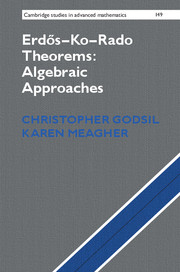Book contents
- Frontmatter
- Dedication
- Contents
- Preface
- 1 The Erdős–Ko–Rado Theorem
- 2 Bounds on cocliques
- 3 Association schemes
- 4 Distance-regular graphs
- 5 Strongly regular graphs
- 6 The Johnson scheme
- 7 Polytopes
- 8 The exact bound in the EKR Theorem 135
- 9 The Grassmann scheme
- 10 The Hamming scheme
- 11 Representation theory
- 12 Representation theory of the symmetric group
- 13 Orbitals
- 14 Permutations
- 15 Partitions
- 16 Open problems
- Glossary: Symbols
- Glossary: Operations and relations
- References
- Index
11 - Representation theory
Published online by Cambridge University Press: 05 December 2015
- Frontmatter
- Dedication
- Contents
- Preface
- 1 The Erdős–Ko–Rado Theorem
- 2 Bounds on cocliques
- 3 Association schemes
- 4 Distance-regular graphs
- 5 Strongly regular graphs
- 6 The Johnson scheme
- 7 Polytopes
- 8 The exact bound in the EKR Theorem 135
- 9 The Grassmann scheme
- 10 The Hamming scheme
- 11 Representation theory
- 12 Representation theory of the symmetric group
- 13 Orbitals
- 14 Permutations
- 15 Partitions
- 16 Open problems
- Glossary: Symbols
- Glossary: Operations and relations
- References
- Index
Summary
Many of the graphs we consider in this book admit a large group of automorphisms. For example, the symmetric group Sym(n) acts as a group of automorphisms of the Johnson graph J (n, k). In some situations it is possible to use information about the group to derive information about the eigenvalues and eigenvectors of the graph, and this can allow us to derive theorems of EKR type. The group theoretic information needed comes from representation theory, and this chapter provides a reasonably self-contained introduction to this subject.
Representations
A representation Φ of a group G over the field F is a homomorphism from G into the group of invertible linear maps of some vector space V over F. For our purposes G is finite and V is a finite-dimensional vector space over C. The dimension of V is called the dimension of the representation. If Φ is a representation of G, we will denote the image of an element v of V under the action of an element g of G by Φ (g) v, or simply by gv when the choice of representation is irrelevant. As a representation corresponds to a homomorphism of the group algebra F[G] into End(V), it follows that V is a G-module. Hence we can express our thoughts on representations using the language of modules; this is often more convenient for developing the theory, but can be less useful when we have to do calculations.
We consider some examples. The first and simplest is the trivial representation. This representation maps each element of G to the identity map on a 1-dimensional vector space. We will often denote the trivial representation of G by 1G.
For our next example, let Gbe a permutation group on a set Ωand let V = F Ω. We can identify the points of Ω with the standard basis of V. Each element g of G then determines a permutation of this basis, and therefore it determines an endomorphism Φ (g) of V. We say Φ is the permutation representation of G. (The term permutation representation is also used to denote a homomorphism from a group in the symmetric group; we will provide a warning if there is a risk of confusion.)
Information
- Type
- Chapter
- Information
- Erdõs–Ko–Rado Theorems: Algebraic Approaches , pp. 210 - 231Publisher: Cambridge University PressPrint publication year: 2015
